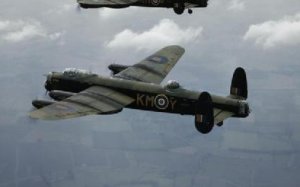![]() The Pacific War Online Encyclopedia
The Pacific War Online Encyclopedia
|
| Previous: Lampang | Table of Contents | Next: Lanchow |

Imperial War Museum #TR 197. Via Wikimedia Commons
Cropped by author
Avro Lancaster B.VII
| Crew | Seven |
| Dimensions | 102'0" by 68'10" by 20'4" 31.09m by 20.98m by 6.20m |
| Weight | 41,000-72,000 lbs 18,600-33,000 lbs |
| Speed | 287 mph at 11,500 feet 462 km/h at 460 meters |
| Cruising speed | 215 mph 346 km/h |
| Climb rate | 4.5 feet per second 3.0 meters per second |
| Ceiling | 24,500 feet 7470 meters |
| Power plant | Four Merlin 24 V12 engines rated at 1620 hp |
| Armament | Eight .303 machine guns in nose, tail, and dorsal turrets |
| Bomb load | 14,000 lbs 6350 kg |
| Range | Normal 1040 miles (1670km) with 10,000 lb (4500kg) bomb load Maximum 2678 miles (4310 km) |
| Production | A total of 7377 Lancasters were built. Of these, 180 were the B.VII model intended for use in the Far East. |
The Lancaster first came into service in 1941 and was built by numerous
manufacturers in Britain and Canada.
It was one of the two main British strategic bombers of the
Second
World War and proved suitable for special missions and capable of
carrying the most sophisticated avionics developed in its day.
The Lancaster saw little operational use outside of Europe. However, manufacture of the aircraft began in Australia in 1944 for use in the Far East, and a considerable force of Lancasters would have supported DOWNFALL if the Japanese had not capitulated.
References
The Pacific War Online Encyclopedia © 2007, 2012 by Kent G. Budge. Index